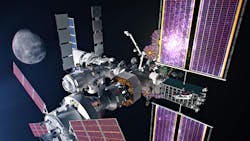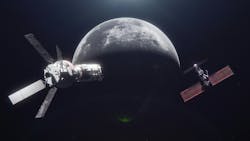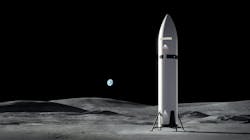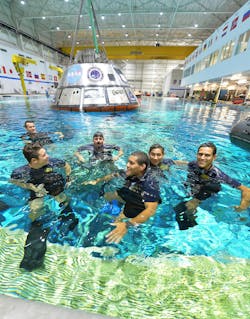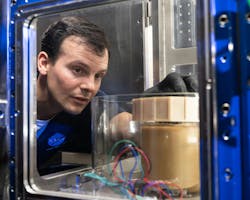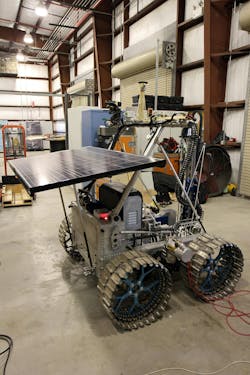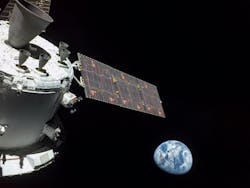It's been more than half a century since humans first walked on the moon. American astronaut Neil Armstrong first set foot there in July 1969. The last human on the moon left in the lunar module just three years later, and no one has been there since. Fifty-three percent of the world's population today weren't even born when NASA astronaut Eugene Cernan climbed into the lunar module in December 1972 for humanity's final return trip from the moon.
Now United States space exploration is set to return to the moon as early as 2027. But why do this after pouring the equivalent of $300 billion in today's dollars into the mid-20th century's Apollo program? It comes down to establishing a stepping stone toward putting the first humans on Mars sometime in the mid-to-late 2030s, with permanently crewed bases on the moon to launch and support Mars missions and help humans learn how to live and work for long periods away from Earth.
Besides using the moon as a jumping-off place for future Mars missions, scientists want to capitalize on a permanent lunar presence to search for resources like water and valuable minerals that could help support humans on the moon and perhaps bring back home. Scientists also want to develop new space technologies like creating breathable air from elements found on the moon, and developing robots to support life away from Earth. Politically, a permanent presence on the moon could help maintain U.S. technological leadership in its continuing competition with Western Europe and countries like China, India, and Russia.
Establishing bases on the moon and a human presence on Mars won't come cheap. Estimates hover around half a trillion dollars to get humans to Mars via the moon, and probably a lot more to keep them there for any length of time.
Moon to Mars Architecture
The foundation of U.S. efforts to return to the moon and use it as a springboard to Mars is the Moon to Mars Architecture plan of the U.S. National Aeronautics and Space Administration (NASA) in Washington. The plan has four parts: sending humans back to the moon; establishing long moon missions; establishing permanent human bases on the moon; and finding ways to send humans from the moon to Mars and back to Earth.
The Moon to Mars Architecture revolves around enabling technologies that involve autonomous systems and robotics; communications; habitation; finding and using resources on the moon; logistics for supporting humans on the moon; ways to ease human movement in low gravity on the lunar surface; generating electric power and using it efficiently; and finding ways to transport humans around the moon and Mars quickly and efficiently.
The first segment of the Moon to Mars Architecture includes the NASA Artemis missions, which will return humans to the moon for the first time in 53 years. These missions will develop and test human and cargo transportation; lunar communication relays; and demonstrate technologies necessary for Mars exploration. The Artemis missions prepare the groundwork by proving key capabilities in lunar orbit and surface operations.
This involves developing crewed spacecraft and satellites that orbit the moon; deep-space communications and tracking; transportation between lunar orbit and the moon's surface; human landing systems; spacesuit and moon walking technologies; and moving uncrewed payloads between lunar orbit and the lunar surface.
The next segment will expand lunar surface operations with relatively long missions, increased mobility, and exploration of the lunar south pole -- including sustained orbital operations, reconnaissance, initial infrastructure development for a long-term lunar presence, and develop enabling technologies for future Mars missions.
Next will be establishing long-term human presence on the moon by finding and using lunar resources for human survival, sustainment, and goods and services.
After this, NASA officials focus on attempts to place humans on Mars for the first time. This segment will find ways for humans to travel safely to Mars, land on the Martian surface, conduct scientific experiments, and then return to Earth. After the first Mars missions, NASA officials seek to undertake longer and more complex missions to the Mars.
The Moon to Mars Architecture will develop technologies for high-priority lunar exploration conducted best by on-site human astronauts; the influence of the sun on the lunar and Martian environments, and how the sun influences planetary weather; the influence of the lunar and Martian environments on human health; machine automation and robotics; and lunar and Martian orbital dynamics.
Human lunar return
Systems and technologies for human lunar return segment involve space launch systems; the Orion spacecraft; ground systems for surface exploration; and so-called Gateway technologies for an orbiting lunar space station that will be launched and assembled separately. Gateway technologies involve power and propulsion, habitation, and logistics.
Other technology-development goals of human lunar return involve lunar supply and resupply; landing systems to transport astronauts and cargo between lunar orbit and the lunar surface; space suits, tools, and lunar vehicles; and communications, positioning, navigation, and timing for maintaining communications among the lunar surface, lunar orbit, and controllers on Earth.
Moving humans to Mars initially will involve sending four astronauts to Mars orbit, and landing two of them on the Martian surface for 30 Martian days, which are slightly longer than Earth days. Estimates place this initial Mars mission to launch by the late 2030s or early 2040s, with round-trip travel taking about 500 days, or one year and five months.
Then several Mars landers will descend to the planet's surface to deploy cargo for future human missions. After that, NASA will develop an initial Mars surface infrastructure involving minimal surface power generation and communications, but no surface habitation. Then NASA will pursue an all-up mission approach to send astronauts from Earth to Mars with all the fuel they will need to get to Mars and then back to Earth.
The Orion spacecraft is designed for deep space exploration, including missions to the moon and eventually Mars. Orion has a crew module with life support, flight controls, and glass cockpit; the European Service Module for propulsion, solar power, air, and thermal control; can sustain astronauts for as long as 21 days undocked from other spacecraft, and as long as six months when docked. Orion offers radiation shielding, a heat shield for Earth reentry, and deep space communication and navigation systems.
Artemis: the first step
The foundational project to get humans back to the moon -- and eventually to Mars -- is the NASA Artemis program, which seeks not only to develop the launch equipment, rockets, and spacecraft to return humans to the moon, but also to build the habitation, power generation, and resource management to keep them there for sustained periods -- leading eventually to a permanent human presence on the moon.
Plans include building places on the moon's surface for humans to live and work on a permanent basis, as well as building a space station called the Lunar Gateway that will orbit the moon to explore the lunar surface in detail and to make astronomical observations. The Gateway will support lunar landings -- particularly the lunar south pole -- and space exploration beyond the moon.
The Gateway space station also will be a communications relay between the moon and Earth, and will stage lunar landers and visiting crew vehicles. The Gateway will serve not only NASA, but also the European Space Agency (ESA), the Japan Aerospace Exploration Agency (JAXA), the Canadian Space Agency (CSA), and the Mohammed Bin Rashid Space Centre (MBRSC) of the United Arab Emirates.
The Gateway will provide solar electric power and propulsion, have living and work area for astronauts and visiting astronomers, and will support modules for storage, communications, refueling, and docking. Gateway will not be permanently crewed, but instead will operate autonomously between crewed Artemis missions, with astronauts visiting for weeks to months at a time. Artemis IV astronauts are to be the first to inhabit the Gateway in 2028 or 2029.
The Gateway's core modules, such as the Habitation and Logistics Outpost (HALO) and Power and Propulsion Element (PPE), are under construction, and should begin orbital assembly around the moon as early as 2027. The two Gateway modules are set to launch together on a SpaceX Falcon Heavy rocket within the next two years.
Artemis missions
The first Artemis mission, the uncrewed Artemis I, launched in November 2022 from Kennedy Space Center, Fla. The 25-day mission involved an Orion spacecraft lunar flyby, a distant retrograde orbit around the moon, and a second lunar flyby before returning to Earth in December 2022. This mission demonstrated the launch rocket and spacecraft, tested Orion’s heat shield, and gathered data on radiation exposure, which showed lower cosmic ray exposure than expected.
The 10-day crewed Artemis II mission is set for next year, and will send four crew members around the moon and return to Earth. It will be the first crewed flight of the Orion spacecraft, and will test the performance of Orion systems like life support; perform rendezvous and proximity checks; demonstrate the Orion Artemis II optical communications system with downlink speeds as fast as 260 megabits per second; and validate crew interfaces, guidance, navigation, and spacecraft systems.
The Artemis III, which will land astronauts on the moon, is set for launch in mid-2027, and will be the first crewed lunar landing since 1972. Two astronauts will land at the moon's south pole aboard the SpaceX Starship Human Landing System. They will stay for about a week, while two astronauts remain aboard the orbiting Orion spacecraft before the crew reunites and returns to Earth. The moon's south pole receives only limited sunlight, and the sun never moves high in the sky there.
The goals of the Artemis III are to conduct as many as four moon walks for scientific observations, and collect samples of water ice to gauge the feasibility of using this water for long-term lunar habitation. Artemis III will drop-off a remote-control lunar rover for future missions to the dark side of the moon to search for more water ice deposits. This mission also will demonstrate advanced space suits with improved mobility and flexibility on the moon.
The Artemis IV mission will launch in late 2028 or 2029, and will deliver and install the International Habitation Module (I-Hab) to the Lunar Gateway space station, and send two more astronauts to the lunar surface. This mission will start assembly, operations, and periodic habitation of the Gateway. On the lunar surface, meanwhile, astronauts will test using lunar habitation and the moon's resources for a long-term human presence.
The I-Hab module aboard the Lunar Gateway will provide orbiting living and working quarters for four astronauts during missions lasting 30 to 90 days. It will have four docking ports for other Gateway elements and cargo ships, lunar landers, and refueling spacecraft, as well as a telecommunications module. The I-Hab will have batteries, heating and cooling, refrigeration, a kitchen, bathrooms, and workstations. It also may have robotic arms and internal robotic interfaces for maintenance when humans are not aboard.
The Artemis V mission will launch in the early 2030s, and will use the Blue Origin Blue moon lander. As in previous missions, it will send two astronauts to the Gateway station, and land two astronauts on the moon's south pole. The mission also will deliver the European Space Agency's ESPRIT refueling and communications module, a Canadian-built robotic arm, and NASA's Lunar Terrain Vehicle.
Beyond the moon to Mars
NASA plans to send astronauts to the surface of Mars in the mid-to-late 2030s, potentially as early as 2035. Each mission could take as long as two years, with round-trip travel time of about six to seven months, and as long as 500 days on Mars. While on the Martian surface, astronauts will sustain themselves over the long term by conserving food, water, and other resources, as well as growing crops.
For the early Mars missions, NASA is developing advanced propulsion that could involve nuclear thermal and nuclear electric propulsion, life-support, radiation protection, and surface exploration equipment.
A host of electronic technologies will be necessary to support an initial and eventually a sustained human presence on Mars. NASA and private industry have less than 15 years to develop them, if estimates of when the first people will land on Mars hold true.
The Martian surface environment is far more harsh compared to Earth. Mars is cold, dry, and dusty, with a thin, carbon dioxide-rich atmosphere, and the surface is desert-like, with tall mountains and deep valleys. It has an atmospheric pressure less than 1 percent of Earth, which makes it impossible for humans to breathe unaided, for stable liquid water to exist, and that offers little protection from cosmic and solar radiation. Surface temperatures range from extremes of -225 and 70 degrees Fahrenheit, with strong winds and months-long dust storms. Gravity is about one-third that of Earth.
Still, compared to the moon, the Martian surface is not as harsh, which makes the moon a worthwhile proving ground for new systems and electronics. The moon, for example, has no atmosphere, while Mars has a thin atmosphere that can provide partial protection against radiation and micrometeorites. The moon has higher surface radiation than Mars, and is more vulnerable to solar flare radiation.
To ensure safety, health, and operational capability on Mars, new electronic systems will be necessary for power generation, communications, life support, mobility, medical care, environmental control, and automation. It's unknown if humans could live long-term on the Martian surface, or would have to live underground.
Nuclear fission reactors are being developed as the primary source of power on Mars due to their reliability compared to solar. Ruggedized power management electronics also will be necessary for Mars habitation. Laser communications on Mars will be necessary to transmit large amounts of data and video between Mars and Earth, because lasers offer far higher bandwidth than RF links, and will reduce data transmission times from years to weeks for large files.
Electronics technologies for Mars
Advanced electronics also will be necessary to process breathable air and husband limited water supplies on Mars. These systems will need redundant sensors and intelligent automation to respond to changes and malfunctions without intervention from Earth. Electronic systems also will monitor for radiation, atmospheric conditions, and the structural integrity of human habitation. Industrial automation and sensors will help manage habitat temperature, humidity, air pressure, and filter out toxic gases.
Portable multi-function medical diagnostic and treatment devices able to work autonomously also will be necessary on Mars -- especially with the expected communications lag between Mars and Earth. Mars is 140 million miles from Earth, and laser and RF signals take between 4 and 24 minutes, and even longer for large packages of data. Medical devices on Mars are expected to integrate with centralized health monitoring for crew status and environmental data.
Pressurized Martian rovers and robotic assistants must have electronic controls for navigation, life support, and scientific experiments. Space suits must have embedded electronics to monitor astronaut vitals, provide life support, and manage communications, and are expected to have flexible displays, environmental sensors, and self-diagnostics. Artificial intelligence will be necessary to monitor spacecraft and habitat systems, troubleshoot faults, and assist in complex tasks -- particularly because of limited real-time support from mission control.
Enabling technologies in electronics on mars will involve radiation-hardened electronics; redundancy and fault tolerance; and efficient thermal management. Electronics must be able to withstand the effects of radiation, temperature extremes, and the lack of readily available replacements will require built-in redundancy, self-checks, and failover capabilities.
Deep-space exploration
Despite the attention to future crewed missions to explore the moon and Mars, not all future space exploration will be uncrewed -- far from it. Much space exploration is the responsibility of the NASA Jet Propulsion Laboratory (JPL) in Pasadena, Calif. JPL has plans for several uncrewed deep-space probes targeting the moon, outer planets, and the broader universe.
The Europa Clipper mission launched to Jupiter in October 2024 to study the icy shell and subsurface ocean of Jupiter's moon Europa for its potential for future human habitation. The Europa Clipper spacecraft will arrive at Europa around 2030.
The JPL Spectro-Photometer for the History of the Universe, Epoch of Reionization and Ices Explorer -- otherwise known as SPHEREx -- launched last March on a 27-month mission to create detailed 3D maps of the universe, exploring the universe's expansion following the Big Bang, and locating life-supporting ingredients in cosmic ices.
The Lunar Trailblazer mission to map water distribution on the moon launched last February, but so far has not been successful. JPL controllers lost contact with the ship shortly after launch because a faulty power system, and as of July, controllers have not been able to re-establish contact. Scientists say they believe the ship went into a slow spin with its solar panels misaligned, which caused low power generation and eventual loss of telemetry. As of now, the spacecraft is off-course and drifting away from the moon, and it's likely the spacecraft has been lost.
The Cooperative Autonomous Distributed Robotic Exploration (CADRE) mission to place three small autonomous and collaborating rovers on the moon is set for launch next year to map the lunar surface and subsurface using stereo cameras and ground-penetrating radar. Rovers will operate for two weeks on the moon without human control and communicate via a mesh network among the rovers and a base station on the lander.
The VERITAS mission to orbit Venus is set for launch in 2031 to study Venus’s geology and atmosphere to determine why that planet veered away from Earth’s evolutionary path. The Interplanetary NanoSpacecraft Pathfinder In Relevant Environment (INSPIRE) mission to demonstrate cubesats outside Earth orbit does not yet have a scheduled launch date. It aims to validate cubesat communication, navigation, and data collection for future low-cost interplanetary missions.
Aside from specific deep-space missions, NASA JPL is working on optical deep-space communication technologies; exploring beyond the solar system.
About the Author
John Keller
Editor-in-Chief
John Keller is the Editor-in-Chief, Military & Aerospace Electronics Magazine--provides extensive coverage and analysis of enabling electronics and optoelectronic technologies in military, space and commercial aviation applications. John has been a member of the Military & Aerospace Electronics staff since 1989 and chief editor since 1995.
